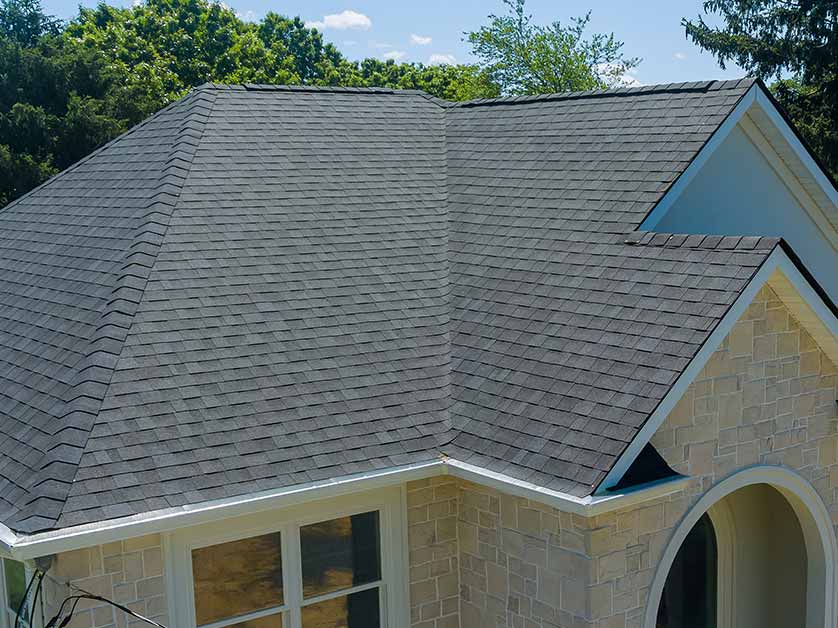Your roof is made of more than just shingles. It’s comprised of several parts, some of which are visible while others are hidden. They work together to keep your indoor spaces safe, dry and comfortable. There are areas of a roofing system that are more prone to issues than others. Understanding how to care for them will go a long way prolonging the life of your investment.

Keep reading to discover the most vulnerable parts of your roof and how to care for them.
What Are the Most Vulnerable Parts of Your Roof?
Valleys
A roof valley is where two roof slopes intersect. It helps drain water properly from your roof. Roof valleys are constantly exposed to moisture, making them susceptible to leaks. Beware of cracks and dips in the shingles surrounding the valley. If you can access your attic, regularly check the valley area for indications of water infiltration.
Flashing
The primary role of flashing is to prevent water from seeping into roof protrusions, such as skylights, chimneys and vents. This thin piece of metal is necessary to prevent roof leaks. You can usually get it in aluminum, copper and steel.
Ridge Vent
With good airflow, your attic will stay in moderate temperatures, protecting various roofing components from early deterioration. A ridge vent is an exhaust vent installed on the highest point of your roof.
Pipe Boots
Professionals use rubber boots to seal vent pipes. This component is typically rubber, a material that can weaken and become brittle over time. Once pipe boots develop cracks, water could enter your attic.
Shingles
Every day, shingles face outdoor elements, such as UV rays and winds. Because they are the most exposed part of our roof, they are at high risk of developing damage during severe weather. Scheduling routine inspections from reputable roofing professionals can contribute to the efficiency and longevity of asphalt shingles.
Gutters
Aside from protecting your roof from damage, gutters can prevent erosion, basement flooding and foundation issues. Regular cleaning is necessary to prevent debris, like seeds, leaves and twigs, from building up and causing clogs. When this happens, water could pool on your roof and overflow to the rest of your home’s exterior, increasing the likelihood of water damage.
What Can You Do to Protect These Components?
Work With a Reputable Roofer
Many roofing problems stem from improper installation or poor workmanship. That’s why you should carefully choose the contractor you will hire for your roofing project. You will benefit from working with a local company specializing in your preferred material.
It helps to obtain multiple estimates before hiring a roofer. When comparing quotes, price shouldn’t be the only thing you should consider. Factor each candidate’s experience and the quality of the materials they use. Don’t forget to verify credentials, run background checks, read online reviews and ask for references.
Schedule Regular Maintenance and Inspections
Routine inspections allow roofing professionals to catch and address minor issues before they require expensive repairs. You should schedule roof maintenance at least once a year. Experts also recommend getting a roof check after weather extremes since not all signs of storm damage are apparent.
Don’t Delay Roof Repairs
If your contractor discovers problems with your roof during inspection, deal with them immediately. Waiting too long to get repairs can harm your roof’s health and longevity. Ignoring existing issues will only worsen them and heighten the risk of leaks. In the future, when you file a claim, and your insurance provider discovers you neglected your roof, they could refuse to pay for the damage.
Have Your Gutters Cleaned Twice a Year
Gutters must be cleaned at least twice yearly, preferably in late fall and spring. It’s to ensure the system remains free from obstructions and stays efficient. If numerous trees surround your home, you might need to clean your gutters more frequently.
To make your gutters easier to maintain, consider investing in a quality gutter protection system. Gutter guards or covers will keep debris from entering your gutters. As a result, you won’t need to worry about constant cleaning. They can also lower the risk of clogs and improve water flow.
Ensure Sufficient Attic Ventilation
Proper attic ventilation can prevent moisture-related issues, including mold growth, rot and poor indoor air quality. Different parts of your roof, including shingles, could deteriorate quickly when your attic overheats. Moreover, in winter, a well-ventilated attic can reduce the risk of ice dams. You can determine if you need to improve your attic ventilation by getting a professional roof inspection.
Besides helping keep your roof in optimal condition, it can contribute to lower energy costs. It prevents heat and humidity from building up in your attic, making your indoor spaces easier to cool. When your HVAC system doesn’t need to work as hard to reach your preferred temperature, you will notice a reduction in your utility bills.
Routinely Trim Nearby Trees
While trees can give your property more life and shade, they can harm your roof when not trimmed regularly. Overgrown branches can scratch or penetrate shingles, causing leaks. They pose even more danger during severe storms. Heavy limbs or unhealthy branches could fall on your roof, resulting in extensive property damage.
Routinely pruning and trimming trees will do more than improve your home’s safety. It can also help keep your trees healthy and allow professionals to detect signs of disease. Experts can remove unhealthy branches to ensure trees remain stable and encourage growth. Investing in regular tree trimming services can help you avoid pest infestation inside and outside your home. Maintaining your trees can also keep your landscaping looking lively and pleasing to the eye.
Leave your roofing needs to a dependable contractor like Sterling Exteriors. Our experienced team also specializes in siding, windows and door installation. We have been providing superior home exterior services for more than 15 years. Call us at (513) 685-8055 or fill out our online form to get a free estimate. We work with clients in Cincinnati, Loveland, Newtown, OH, and nearby communities.






